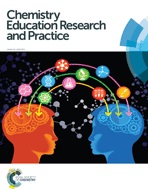Building mental models of a reaction mechanism: the influence of static and animated representations, prior knowledge, and spatial ability†
Abstract
In chemistry, novices and experts use mental models to simulate and reason about sub-microscopic processes. Animations are thus important tools for learning in chemistry to convey reaction dynamics and molecular motion. While there are many animations available and studies showing the benefit of learning from animations, there are also limitations to their design and effectiveness. Moreover, there are few experimental studies into learning chemistry from animations, especially organic reaction mechanisms. We conducted a mixed-methods study into how students learn and develop mental models of a reaction mechanism from animations. The study (N = 45) used a pre-/post-test experimental design and counterbalanced static and animated computerized learning activities (15 min each), plus short think-aloud interviews for some participants (n = 20). We developed the tests and learning activities in a pilot study; these contained versions of an epoxide opening reaction mechanism either as static (using the electron-pushing formalism) or animated representations. Participants’ test accuracy, response times, and self-reported confidence were analyzed quantitatively (α = 0.05) and we found that, while participants showed a learning effect, there were no significant differences between the static and animated learning conditions. Participants’ spatial abilities were correlated to their test accuracy and influenced their learning gains for both conditions. Qualitative framework analysis of think-aloud interviews revealed changes in participants’ reasoning about the test questions, moving toward using rule- and case-based reasoning over model-based reasoning. This analysis also revealed that dynamic and transitional features were incorporated into participants’ working mental models of the reaction mechanism after learning from animations. The divergence of participants’ mental models for reasoning and visualization could suggest a gap in their mental model consolidation.


 Please wait while we load your content...
Please wait while we load your content...